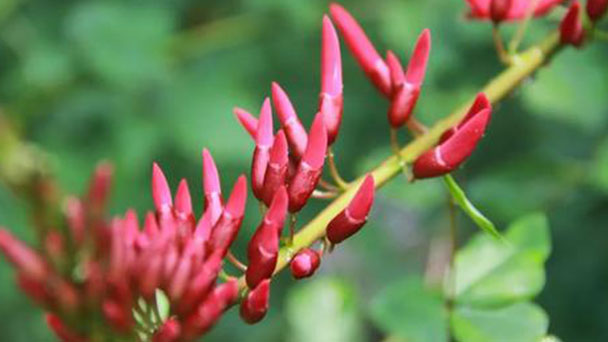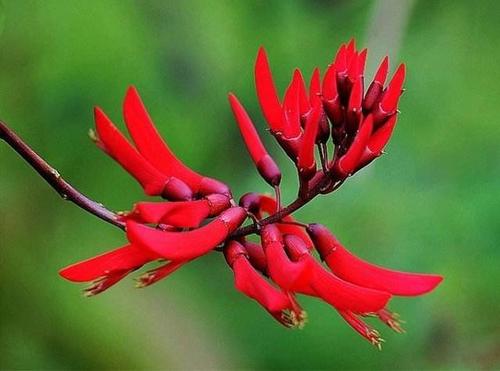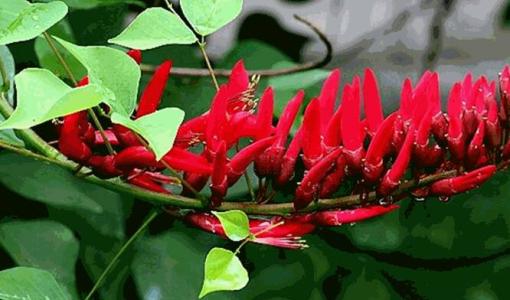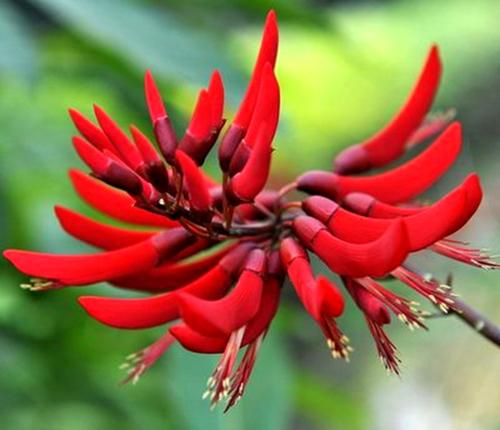Coral Tree profile
Written by Maggie
Jan 18 2021

Coral trees, scientific name Erythrina corallodendron, is a spheniformis plant. The wood is soft and can be used as a peg instead of cork. The bark contains Coral Tree element, can be medicinal, anesthetic, sedative effect. The bark and fresh seed juice can damage the animal's nervous system and cause dizziness when ingested.
Coral trees picture

The characteristics of Coral trees
Coral Tree is a shrub or small Tree, 3-5 m tall. Dry and branches scattered rawhide thorns.
Leaves: Coral Tree pinnate compound leaves with 3 leaflets; Leaflets are rhomboid ovate, 4-10 x 2.5-7 cm, apex acuminate obtuse or caudate, base broadly cuneate, glabrous on both surfaces, sometimes spiked on petiole and midvein below.
Flowers: Coral Tree racemes are axillary, up to 30 cm long; Flowers are dark red, shortly pedicled, at right angles to or slightly recurved to inflorescence axis, 4 -- 6 cm long, narrow and sub closed; Calyx is campanulate, calyx teeth not obvious, only the lower one slightly protruding; The flag valve is elliptic, about 4.2 cm long, apex emarginate, slightly stalked to nearly silleless, winged valve is short, 1.4 cm long, keel valve is 2.2 cm long, all without stalks; Stamens are disome, irregular, slightly shorter than flag valve; Ovary is with long ovary stalks, white pubescent, style glabrous. Coral trees bloom from June to November.
Fruit: The pod of Coral Tree is about 10 cm long, pedicled, apically beaked, and constricted between seeds; It has many seeds, deep red, with a black spot.
The function of Coral Tree
Coral Tree is soft and can be used as a cork for a peg.
Landscape use: Coral Tree is a beautiful ornamental plant. The leaves are sparse and bloom in early summer. The racemes of deep red flowers look like a series of red crescents, gorgeous and eye-catching. They are suitable for planting in parks and courtyards.

Growing methods of Coral trees
Potted method: Change basin in spring every year, undertake pruning plastic shape, cut off dead branches and short cut long branches, make form flower branches more. In the growing period every half a month fertilizes 1 time, the flowering period increases 1- 2 times phosphate potash fertilizer. The midsummer needs to keep the basin soil moist.In winter, the old plants are properly planted and renewed to promote the reoccurrence of new branches. Open cultivation, every winter furrow fertilization, dry weather irrigation, to keep the soil moist.
Propagation methods of Coral trees
Sowing propagation: after the real living tree flower is fruiting, the fruit pod is swollen, the seed can propagate the seedling. Collection of fruits should not be exposed to the hot sun, dry out of seeds, wet sand storage or placed in 5 'C low temperature storage, to the next year in March sowing. The seeds need to be soaked in hot water at 60-80℃ for a second, and then soaked for a day and a night after cooling, to facilitate orderly germination. Seedlings need 3 to 5 years before flowering for viewing.
Cuttage propagation: production on the multi-purpose cuttage seedling. Before the early spring leaf bud has not yet sprouted, 1-2 years of wood has been selected as cuttings, cut into a 12-15 cm long, inserted into the wet sand bed, often kept wet, about 30 days after the roots, transferred to the nursery cultivation. Cuttage crown is often biased to one side, the crown is also not neat, the influence is beautiful. When the cuttings germinate, we should pay attention to the bud cultivation seedlings, wipe out the weak side seedlings, and grow into the trunk upright high quality seedlings. For potted seedlings, moderate pruning, control high growth, less watering, less fertilization, to make the plant dwarfing, to adapt to the potted needs of Sichuan. And coarse dry cuttings, germination after the year can become a scene. Generally cuttings can flower the next year for viewing.
Disease control of Coral Tree
Winter ground diseases and insect pests: permanent occurrence of blight, anthracnose and root rot, can be used Bordeaux leaf spray river sprinkle 2- 3 times, or with 50% sterilization of special wettable powder 1000 times the liquid spray. The insect pest has the root nodal line insect pest, irrigates with 80% two bromochloropropane emulsion dilution. Department wither, timely repair, which is conducive to the next spring germination of new branches.

Latest Updated
- Benefits of Bugleweed - 7 Science-backed Health Benefits
- Bugleweed Dangers & Side Effects - Is It Poisonous?
- How to Plant Evergreen Trees - What You Should Know
- When to Plant Evergreens - Grow Guide for Evergreen Trees
- 12 Wonderful Evergreen Shrubs for Your Garden
- 12 Popular Evergreen Plants with Pictures for Beginners
- When And How To Prune A Lilac Bush Like a Pro
- How to Grow & Care for Lilac Vine (Hardenbergia Violacea)
- Japanese Lilac Tree (Syringa Reticulata) Care & Propagation Guide
- Shumard Oak Pros and Cons - What to Know
Popular Articles
- Winter maintenance of Antirrhinum Majus
- How to Grow Terminalia Mantaly Tree
- How to Grow and Care for Crossostephium Chinense
- How to grow Antirrhinum Majus in spring
- Peristeria Elata (Dove Orchid) Profile: Info & Care Guide
- Underwatered Snake Plant (Sansevieria Trifasciata) - Signs And How To Fix
- How to Care for Brazilian Jasmine Plant (Mandevilla Sanderi)
- How to Grow & Care for Graptopetalum Purple Delight in Summer
- Rosa Chinensis (China Rose): Plant Growing & Care Tips
- How to Care for Baby Sun Rose (Aptenia Cordifolia)